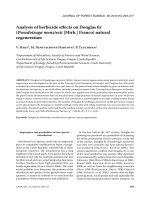Báo cáo lâm nghiệp: "Variation of stomatal resistance with leaf age in Quercus petraea: effect on the soil-water balance of an oak forest" pot
Bạn đang xem bản rút gọn của tài liệu. Xem và tải ngay bản đầy đủ của tài liệu tại đây (496.31 KB, 4 trang )
Variation
of
stomatal
resistance
with
leaf
age
in
Quercus
petraea:
effect
on
the soil-water
balance
of
an
oak
forest
J.
Nizinski,
D.
Morand
B. Saugier
Laboratoire
d’Ecologie
V6g6tale,
CNRS
URA121,
Bitiment
362,
Universit6
de
Paris-Sud,
91405
Orsay
Cedex,
France
Introduction
In
deciduous
forests,
evapotranspiration
follows
variations
in
the
leaf
area
index
(LAI).
It
is
thus
expected
to
reach
a
maxi-
mum
in
spring
when
the
LAI
reaches
a
plateau
and
when
the
soil
water
supply
is
adequate.
From
a
detailed
study
of
the
soil-water
balance
over
3
yr,
we
found
that
evapotranspiration
reached
a
maxi-
mum
nearly
1
mo
after
the
leaf
area
index
(Nizinski
and
Saugier,
1988;
1989a,
b).
We
thus
decided
to
study
the
effect
of
leaf
age
on
stomatal
resistance
and
on
the
morphology
of
the
leaf
epidermis.
Materials
and
Methods
Study
site:
2
stands
of
Q.
petraea
(Matt.)
Liebl.
in
the
Fontainebleau
forest
(1981-1983)
and
on
the
Orsay
campus
(1987);
soil-water
balance
measurements:
rain
gauges,
stemflow
collars,
neutron
probe;
stomatal
resistance
(Delta
T
Mk-
3
porometer)
in
the
middle
of
the
day;
leaf
size
(Delta
T
area
meter)
and
the
observation
of
the
abaxial
epidermis
(scanning
electron
micro-
scope).
Observations
related
to
the
soil-water
balance
Fig.
1
shows
the
strong
decrease
in
sto-
matal
resistance
with
leaf
age,
expressed
as
the
ratio
of
actual
leaf
area
to
its
maxi-
mal
area.
All
these
values
were
obtained
at
high
light
intensity
and
ample
water
supply.
This
curve
is
repeated
in
Fig.
2b,
which
shows
a
further
decrease
in
stoma-
tal
resistance
after
full
leaf
development
(Fig.
2a).
The
decrease
in
stomatal
resis-
tance
led
to
a
progressive
increase
in
the
ratio
of
real
transpiration
to
potential
(Pen-
man)
evaporation
(TlETP)
from
0
at
bud
burst
to
about
0.5
at
the
end
of
leaf
growth
and
to
0.8
at
the
end
of
June.
Morphology
of
leaf
epidermis
Scanning
electron
microscopy
of
the
leaf
epidermis
revealed:
1)
young
leaves
have
that
have
not
achieved
their
development.
They
are
covered
with
a
dense
net
of
hairs
(Fig.
3,
1a
and
2a);
2)
as
the
leaf
matures,
all
stomates
end
their
development
and
hairs
progressively
disappear
(Fig.
3,
1
b and
2b).
The
decrea-
se
in
epidermal
resistance
after
the
leaf
has
reached
its
full
size
may
thus
be
attri-
buted
to
both
stomatal
development
and
a
decrease
in
boundary
layer
resistance.
References
Nizinski
J.
&
Saugier
B.
(1988)
A
model
of
leaf
budding
and
development
for
a
mature
Quer
cus
forest.
J.
Appl.
Ecol.
25,
643-652
Nizinski
J.
&
Saugier
B.
(1989a)
Dynamique
de
1’eau
sous
chênaie
(Quercus
petraea
(Matt.)
Liebl.)
en
foret
de
Fontainebleau.
Ann.
Sci.
For.
46, 173-186
Nizinski
J.
&
Saugier
B.
(1989b)
A
model
of
transpiration
and
soil-water
balance
for
a
ma-
ture
oak
forest.
Agric.
For.
Meteorol.
in
press









